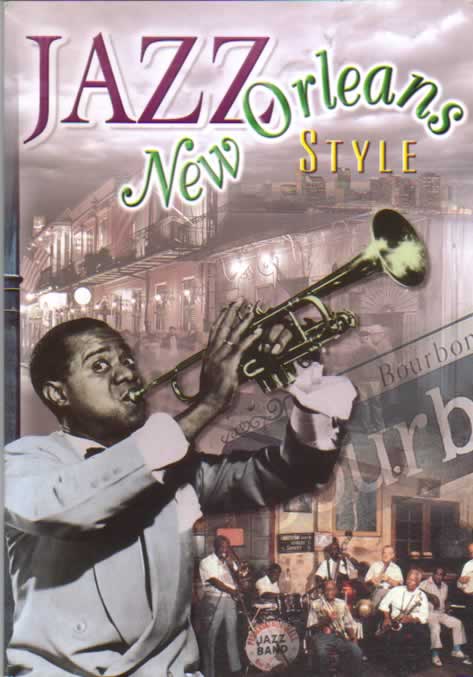 Article taken from:
Article taken from:
Jazz New Orleans Style
by Bobby Potts |
|
|
|
| |
First
in Jazz
(New Orleans, the Birth Place of Jazz)
|
 |
|
|
| |
The Original Dixieland Jazz Band
Because
they were the first jazz band to record music on celluloid,
and the first featured jazz musicians in a movie, The Original
Dixieland Jazz Band was undoubtedly the first band to boost
jazz music into public vision; however, they were not in Dixieland
when it happened. Called the ODJB for short, the band soon became
a tremendous success
People in New York heard their music and
loved it, but they did not know how to match their feet to the
music. They couldn't seem to dance to it and everyone thought
it would die a quick death, but in about two days, they figured
out what to do with their feet, and no one could stop them.
Nick LaRocca, a trumpet player, was the leader of the band.
He next took the band to London, and explosion it caused was
something like when the Beatles came here, only in reverse.
Edward "Kid"
Ory....became a real pioneer in the world of jazz and blues.
The "Kid," who played a mean trombone, made the
first recording of a black New Orleans band, called Spike's
Seven Pods of Pepper Orchestra. Ory apparently developed the
light high notes of the trombone, adding a new sound to jazz,
and was also a great blues musician. He played in the recording
of Louis Armstrong's Hot Five, a band which never existed
outside the recording studio.
"Jelly Roll"
Morton was the first to smooth and blend the ragtime beat
with the sound of jazz. Considered jazz's first great composer,
Morton wrote "Mr. Jelly Roll," "The Shreveport
Stomp," "The Black Bottom Stomp," and Milneburg
Joys." Milneburg was a sort of resort at the end of the
street car line out on Lake Pntchartrain. It was a favorite
place for New Orleansians to relax and enjoy life in the summertime.
Morton began playing piano in Storyville when he was only
ten years old. "Kid" Ory played for him at one time.
Morton performed in Washington, D.C., before heading on to
New York, but eventually faded away.
W.C. Handy, the King
of Minstrelsy, formalized the blues. Handy wrote down music
previously passed on by word of mouth. He also composed some
outstanding songs, the most famous being "St. Louis Blues."
It needs to be said here that Handy never of himself as a
jazz musician. He, liked Eubie Blake, was a product of the
pre-jazz "novelty" music. Handy said they played
music similar to jazz in the minstrel days, but they did not
call it jazz. Minstrel shows began to hire jazz artists and
this really helped to make jazz popular.
In 1920, Mamie Smith recorded the first blues song, "Crazy Blues." These
early recordings gave blues and jazz great impetus. Sidney
Bechet was the first important recorded jazz soloist; Louis
Armstrong ran a close second a few months later.
GertrudePridgett, known
as "Ma" Rainey,
was the first important singer to
present the classic blues tradition, making blues and early
jazz meet.
"Ma" Rainey
taught Bessie Smith, who left the minstrel circuit to sing
as a soloist. As the first important female jazz singer, Bessie
was far ahead of most of her accompanists. It has been said
that Fletcher Henderson and Fred Longshaw were the only ones
who could do justice to her singing. Smith and Henderson were
featured in a movie.
When Duke Ellington opened at New York City's The Cotton Club, jazz was on its
way! Ellington made more contributions to jazz than are possible
to count. His orchestra was always in the top five, and Ellington
ranked with George Gershwin, Cole Porter, and Irving Berlin.
He wrote so many songs - thousands - that no one has ever
been able to count them. Ellington constantly rearranged his
music so that it was always fresh.
He first began playing
in Washington, D.C., in 1917, learning ragtime. His first
composition was "Soda Fountain Rag," and his first
concert at Carnegie Hall was in 1943. Jazz was not yet known,
but when it hit he was ready, opening at The Cotton Club in
1927. Nearly all of the famous jazz artists played with him
at one time or another. Duke Ellington was truly a national
treasure.
The Assunto brothers,
Frank and Fred, were just kids when all of this was going
on. By the time the brothers were teenagers, they wanted a
band of their own to play Dixieland music.
The brothers talked
to their father, "Papa Jack," into playing with
them. "Papa Jack" later became their manager. Calling
themselves the Dukes of Dixieland, the band opened in 1948.
For 44 consecutive months, they played at the Famous Door.
The Assuntos had a lot to do with preserving the trombone;
"Papa Jack" played trombone and banjo. Gradually
other musicians joined the band. The Dukes of Dixieland could
play slow, lowdown gut struts or fast jive with a swing that
left dancers exhausted. It was said the Assuntos could almost
blow a man head over heals backwards, they blew such a hot
horn.
Tragically, Fred died
a premature death in 1966, followed by Frank in 1974. Some
of the members tried to constitute the band but it was never
the same. "Papa Jack" retired to teach music, and
died in 1985. Nevertheless, they remain a bright spot in everyone's
memories of Dixieland jazz.
|
|
 |
 |
|